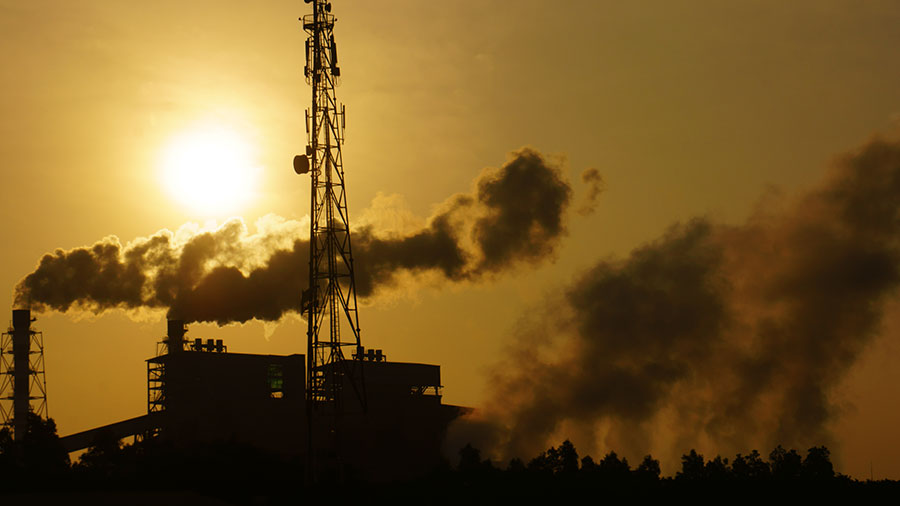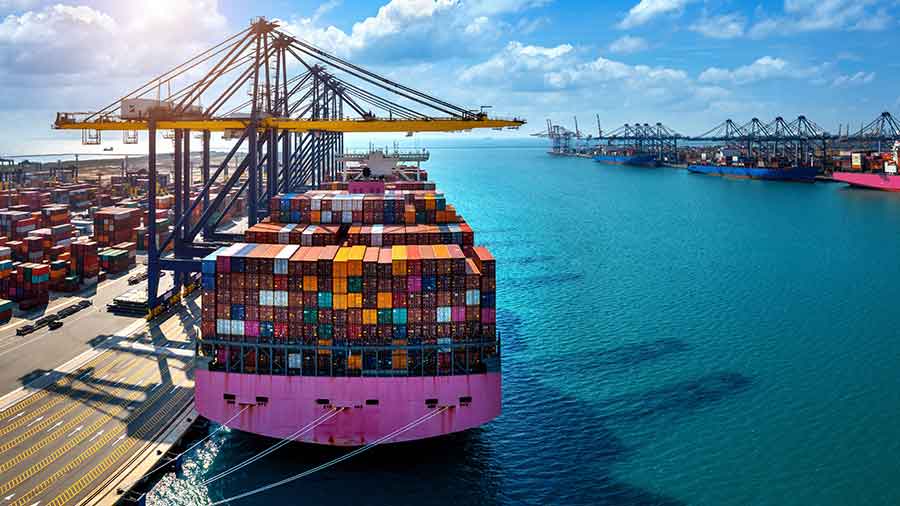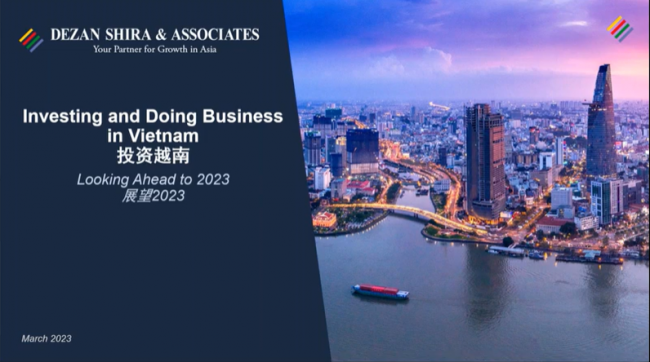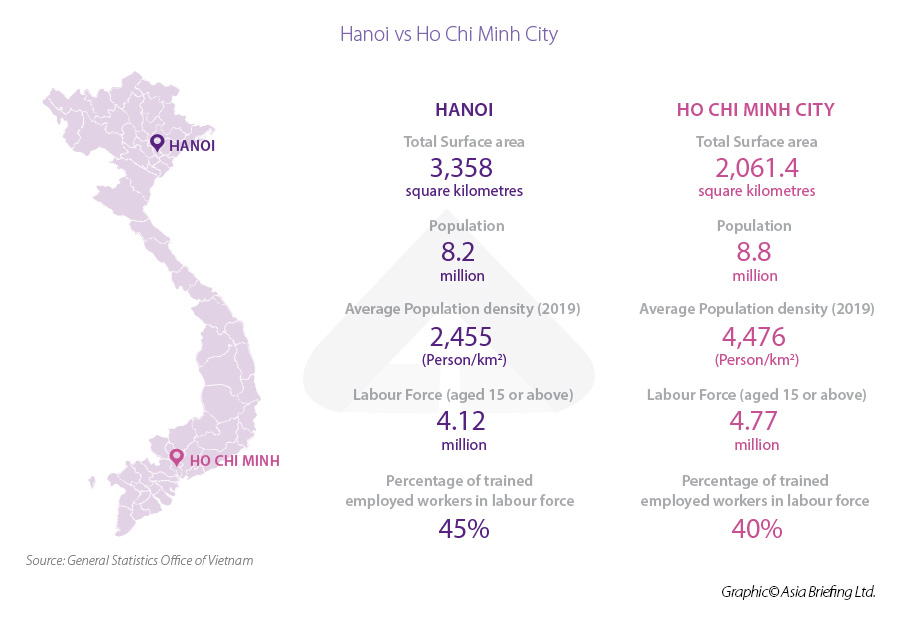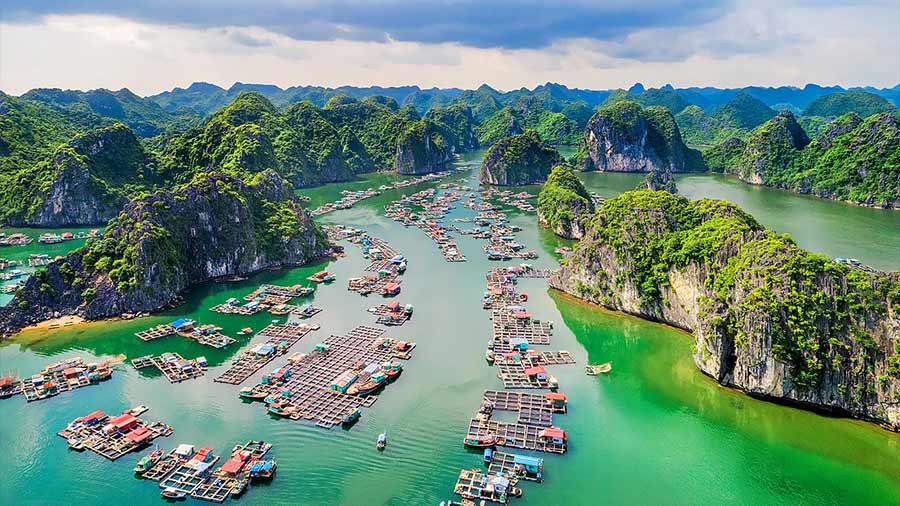Hanoi, the capital city of Vietnam, boasts a strong investment profile, having registered FDI worth US$2.28 billion in the first seven months of 2023. Hanoi benefits from a conducive business climate, robust infrastructure, and a wealth of skilled professionals. To bolster its investment allure, Hanoi has adopted the National Digital Transformation Programme by 2025, with a vision towards 2030, to develop digital government, digital economy, and a digital society.
Hanoi investment profile
Vietnam’s capital Hanoi is the largest economy of the Northern Key Economic Region (KER), which also encompasses six other provinces and cities—Hai Phong, Quang Ninh, Vinh Phuc, Bac Ninh, Hai Duong, and Hung Yen.
Hanoi is home to 8.2 million people and is the second largest city in Vietnam after Ho Chi Minh City. Its business environment, infrastructure, and a high percentage of trained employed workers make it a highly competitive location for establishing a business.
FDI inflow into Hanoi and growth estimate
Hanoi continues to be one of the leading localities for foreign direct investment (FDI). In 2022, Hanoi ranked among the top seven destinations nationwide in terms of FDI inflow, attracting US$1.7 billion. In the first seven months of 2023, Hanoi's total registered FDI capital was US$2.28 billion.
In the first six months of 2023, Hanoi’s gross regional domestic product (GRDP) increased by 5.97 percent over the same period in 2022. However, its growth for the whole year is expected to be upwards of 7 percent.
Hanoi and Ho Chi Minh City are two localities with the largest number of enterprises in Vietnam. In the first eight months of 2023, Hanoi recorded 21,100 new enterprises in the city. These enterprises had a combined capital of VND 208.8 trillion (US$8.65 million).
Ranking in the Provincial Competitiveness Index on key metrics for doing business
|
Year |
2022 |
2021 |
2020 |
2019 |
2018 |
|
Entry costs |
6.47 |
6.57 |
6.74 |
7.98 |
8.20 |
|
Access to land |
6.21 |
6.60 |
6.07 |
6.63 |
5.87 |
|
Transparency |
6.32 |
5.21 |
5.81 |
6.60 |
5.83 |
|
Time costs |
7.82 |
8.45 |
7.93 |
7.18 |
7.07 |
|
Informal charges |
6.75 |
7.15 |
6.72 |
5.94 |
5.56 |
|
Policy bias |
6.49 |
5.38 |
6.06 |
5.39 |
4.48 |
|
Proactivity |
6.35 |
6.92 |
6.06 |
5.96 |
5.13 |
|
Business support policy |
6.24 |
7.74 |
6.68 |
7.06 |
7.21 |
|
Labor policy |
7.51 |
7.64 |
7.85 |
7.91 |
7.80 |
|
Law & order |
7.23 |
6.60 |
6.21 |
6.30 |
5.53 |
|
PCI scores |
66.74 |
68.60 |
66.93 |
68.80 |
65.40 |
|
Ranking |
20/63 |
10 |
9 |
9 |
9 |
Source: PCI Vietnam
Since 2005, the Provincial Competitiveness Index (PCI) in Vietnam has annually surveyed and ranked provincial authorities' economic governance in support of private sector development. PCI is supported by VCCI and USAID.
The overall PCI consists of ten sub-indices reflecting key aspects of economic governance impacting private sector growth. A high-ranking province excels in:
- Low business start-up costs.
- Accessible land and secure business premises.
- Transparency and equitable business information.
- Minimal informal charges.
- Efficient bureaucratic procedures and inspections.
- Limited preference for state, foreign, or connected firms, in terms of crowding out private activity.
- Proactive provincial leadership in addressing enterprise issues.
- High-quality business support services.
- Effective labor training policies.
- Fair and efficient dispute resolution procedures.
Although Hanoi is highly favored by investors for having a good investment and business climate, it has slipped in the rankings with some sub-indexes falling in recent years—when compared to other rapidly developing provinces.
To address this, the Hanoi People’s Committee issued Directive No 14/CT-UBND in 2021 on improving Hanoi's PCI ranking to reach the topmost ‘excellent’ tier. It highlights the need to implement drastic measures to address the decline in two crucial sub-indices: 'time costs' and 'business support policies'.
This directive points to having all business registration dossiers handled online, and ensuring the settlement of business registration procedures are completed on schedule or ahead of schedule.
Government reforms to promote investment in Hanoi
The Vietnam government's priority is to increase investment promotion in fields that bring high added value, such as manufacturing and processing, logistics services, tourism, education, healthcare, high-tech projects, preservation and processing industry, and clean energy among others.
Regarding trade promotion and agriculture, there is a concerted effort to cultivate export markets and enhance the competitiveness of Hanoi's products, facilitating their entry into promising markets.
Hanoi has also issued many policies and reforms to assist businesses in overcoming economic downturns due to COVID-19. In November 2021, the city had issued Plan No.246/KH-UBND on safe, flexible economic recovery and adaptive development, and effective control of the pandemic in the fourth quarter of 2021 through 2023.
As part of the COVID recovery plan, Hanoi will continue to boost its healthcare system, maintain sustainable economic development, and ensure a balanced budget. Meanwhile, the city aims to implement more administrative reforms and make changes to improve its investment and business environment.
Economic plan for key industries
Technology
Hanoi aims to be one of five leading localities in the country for digital transformation, information technology, innovation, and cybersecurity by 2025. It has adopted the "National Digital Transformation Programme by 2025", with a vision towards 2030, to develop the capital city's digital government, expand its digital economy footprint, and empower its digital society with better connectivity.
Hanoi has set the target to raise the digital economy's contribution to the city's GRDP to 30 percent, accompanied by a 7 to 7.5 percent growth in labor productivity, all while nurturing the city's thriving startup ecosystem.
Under the plan, Hanoi aims to have all households with registered digital addresses and ensure that 95 percent of households own at least one smartphone by 2025.
Construction projects
In the upcoming years, transport construction projects are expected to continue to be prioritized. As per local authorities, the construction of high rise buildings will be tightly controlled while universities, factories, and hospitals will gradually move to the outskirts.
The authorities propose that land area for transport projects will make up between 12 to 15 percent of total land for all construction projects by 2025, up nearly 50 percent compared to 2020.
This is highlighted by the launch of the country's first metro line in Hanoi in November 2021. The Cat Linh-Ha Dong line, spanning across 13.1 km and consisting of 12 stations, has a total investment of approximately US$886 million.
Hanoi authorities hope the metro will help reduce the chronic traffic congestion caused by 5.7 million motorbikes and nearly 700,000 cars—minimizing the pressure on road transport. By 2030, Hanoi plans to construct nine more metro lines, aiming to drastically reduce traffic congestion and pollution.
Local authorities have also taken attentive measures to improve the quality of life of Hanoians. Hanoi has a plan for developing housing between 2021 and 2025, in which apartment projects are expected to account for 90 percent of the city’s housing. Additionally, Hanoi will allocate a budget of VND 500 billion (US$21.74 million) between 2021-2025 to conduct inspections and assess the quality of all old apartments.
Tourism
Within the first nine months of 2021, tourism was one of the most impacted industries with the number of domestic visitors decreasing by 18.9 percent and international visitors by 85.5 percent over the same period in 2020. In the first eight months of 2023, however, Hanoi welcomed 17 million arrivals. The country has also introduced relaxations to its visa regime.
Hanoi authorities have developed many new product packages while innovating and improving the quality of tourism services. Resolution No. 50/NQ-CP issued by the government on promoting the tourism industry from 2021 to 2025 outlines seven key tasks, including digital application and infrastructure investment to develop tourism, improvement of service quality, and human resources.
Priorities to boost growth
Hanoi wants to attract up to US$40 billion in FDI between 2021 and 2025. Within this period, Hanoi will coordinate with local and foreign organizations to promote urban planning and development. In the 2021 to 2025 socio-economic development plan, Hanoi outlines its aim to provide all households with access to clean water by 2025 and reach 50 to 55 percent in the rate of treated urban sewage.
In its 2021-2025 development strategy and direction to 2030, Hanoi’s People Committee has put science, technology, and innovation as one of its 10 pillars. Under this strategy, it will focus on digital transformation, becoming a smart city, and supporting start-ups on digitalization and innovation, and hi-tech agriculture.
The city also aims to address issues, such as the slow development of industrial zones and clusters, high land rentals, and small-scale support industry, to attract high-quality FDI projects. Hanoi has a developed a program on mitigating traffic congestion in the city for the 2021-2025 period with total funding of VND1.8 trillion (US$80 million).
Specifically, each year, Hanoi targets to resolve seven to 10 traffic congestion hotspots and gradually cut traffic accident rates down by 5 to 10 percent. This will contribute to improving the air quality and environment while reducing pressure on road transport.
Air pollution
Due to Hanoi’s fast development, the city has suffered from chronic air pollution. In 2020, Hanoi had the highest annual average of particular matter (PM) 2.5 among all Vietnam localities as per researchers from the University of Engineering and Technology. PM2.5 are airborne pollutants that are harmful and are easily absorbed in the bloodstream when inhaled.
Hanoi frequently records an Air Quality Index (AQI) of 110-200 or more. A reading of 100 and above is considered harmful. The issue is exacerbated in the winter season, which is dry with less wind. While the metro is expected to alleviate traffic and subsequently the volume of air pollution, more needs to be done so the issue does not become chronic. If it does continue, business leaders may consider shifting their operations to less polluted cities.
Investment outlook
Moving forward, Hanoi want to attract high-quality investments from South Korea, Singapore, Taiwan, the U.S., Europe, Australia, and New Zealand—all key FDI markets for Vietnam.
In the short term, Hanoi's primary objectives include enhancing the efficient allocation of public funds, implementing administrative reforms to optimize the business environment, and improving local budget management.
Given its status as the nation's political, economic, and cultural center, Hanoi must also address pressing challenges, including environmental pollution, traffic congestion, and the need for a skilled workforce. Additionally, fostering collaboration with neighboring regions to leverage their workforce and supporting industries represents a strategic opportunity for the city.


